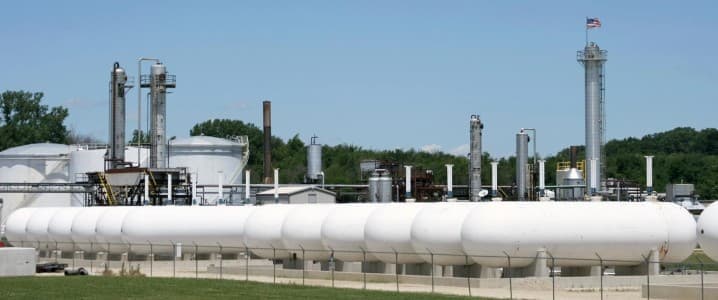Germany and the Czech Republic are pushing the European Union to completely eliminate the remaining energy sources Europe imports from Russia.
There has been no change in the dominant dynamics of the European gas market, with inventories building slower than usual and the markets still proving highly sensitive to supply issues.
Henry Hub natural gas prices have pulled back from their 5-month high of $3.13/MMBtu a week ago to trade at $2.89/MMBtu at Tuesday’s close, still good for a nearly 80% jump from their late-April lows.
U.S. financial markets remained closed on Wednesday in observance of Juneteenth, a day after news about downbeat U.S. retail sales for May raised concerns about lackluster economic activity. According to the Commerce Department’s Census Bureau, retail sales grew just 0.1%, missing expectations for 0.2% growth although inflation-adjusted sales rose 0.4% last month after declining 0.3% in April. The latest report has raised hopes for an interest rate cut in September after the Fed left its benchmark overnight interest rate unchanged in the 5.25%-5.50% range. Henry Hub natural gas prices have pulled back from their 5-month high of $3.13/MMBtu a week ago to trade at $2.89/MMBtu at Tuesday’s close, still good for a nearly 80% jump from their late-April lows.
There has been no change in the dominant dynamics of the European gas market, with inventories building slower than usual and the markets still proving highly sensitive to supply issues. Sudden outages and planned maintenance in Norway coupled with the possibility of further cuts to Russian pipeline supply have held Dutch TTF Natural Gas Futures around the €35 per megawatt-hour mark with money managers raising their bullish bets for a second consecutive week. An unexpected outage at Norway’s Sleipner Riser offshore hub connecting pipelines from the Nyhamna plant on the west coast of Norway with the Easington terminal in the UK sent the Dutch TTF Natural Gas Futures surging by 10% on June 3 to the highest level in six months. Norway has largely replaced Russia as the EU’s largest gas supplier, with the Nordic country supplying 30% of the bloc’s gas compared to 35% supplied by Russia before it invaded Ukraine. Norway’s national oil company (NOC) Equinor ASA (NYSE:EQNR) markets nearly two-thirds of the country’s gas exports. The EU’s natural gas imports from Russia fell more than 70% to 43 billion cubic meters (bcm) in 2023 from 150 bcm in 2021.
Russian gas supply to Europe remains a big wild card. Last week, a Swedish court awarded German utility Uniper SE more than €13 billion ($14 billion) in compensation for undelivered gas by Russia’s Gazprom PJSC during the energy crisis. With Gazprom highly unlikely to pay the damages, payments could be rerouted from European companies such as Austria’s OMV AG that still receive Russian gas. In such a scenario, Moscow is likely to respond by cutting off Austria’s gas supply.
Related: Oil Loses Traction As Traders Focus on Geopolitical Situation
“That’s the one which could impact summer prices the most if suddenly we lose around 6 billion cubic meters a year under the OMV contract,” Anne-Sophie Corbeau, a researcher at the Center on Global Energy Policy at Columbia University, has told Yahoo Finance.
Meanwhile, Europe is moving closer to completely ditching Russian gas. And now reports have emerged that Germany and the Czech Republic are pushing the European Union to completely eliminate the remaining energy sources Europe imports from Russia. According to Reuters, the two countries have asked Brussels to kick off regular high-level talks – potentially among countries’ energy ministers to end the remaining imports of Russian energy. Last year, Russia sent more than 15.6 million metric tons of LNG to the EU, good for a 37.7% jump compared to 2021, the year before Russia’s Ukraine invasion. The move by Germany and the Czech Republic represents the latest attempt by EU members to work to fully sanction Russian gas imports. However, some EU members–including Hungary and Austria–remain heavily reliant on Russian gas. This implies that countries in support of a full ban can expect considerable pushback, with Hungary previously saying it would block such a move. The bloc has already banned imports of Russian coal and sea-borne crude oil, with exemptions for some land-locked countries.
Source: Bruegel.Org
According to Gas Infrastructure Europe (GIE) data, EU gas inventories stood at 81.75 billion cubic meters (bcm), good for 1.1 bcm Y/Y increase and 14.9 bcm above the five-year average. Inventory build over the past week was 1.9 bcm, considerably lower than the five-year average for the same period of 2.8 bcm and last year’s 2.4 bcm. The surplus above the five-year average has fallen on 45 of the past 48 days.
StanChart has predicted that whereas Europe’s gas outages are likely to be short-lived, prices are likely to remain elevated bolstered by slower-than-average inventory builds.
By Alex Kimani for Oilprice.com
More Top Reads From Oilprice.com:
Oil Prices Climb as Sentiment Continues to Improve
India’s New Coal Power Capacity Is Set to Soar in 2024Refining Margins Squeezed as Tepid Demand Casts Shadow Over U.S. Gasoline Market
>>> Read full article>>>
Copyright for syndicated content belongs to the linked Source : OilPrice – https://oilprice.com/Energy/Natural-Gas/Natural-Gas-Outlook-Mixed-Amid-Volatile-European-Markets.html
